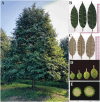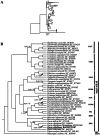The complete chloroplast genome of Durio zibethinus L. cultivar Ri6 (Helicteroideae, Malvaceae)
- PMID: 38737395
- PMCID: PMC11086024
- DOI: 10.1080/23802359.2024.2350619
The complete chloroplast genome of Durio zibethinus L. cultivar Ri6 (Helicteroideae, Malvaceae)
Abstract
Durian, a member of the Malvaceae family, is famous for its delicious fruits, which have strong scents and are rich in nutrients. In this study, we sequenced and characterized the complete chloroplast genome of Durio zibethinus L. 1774 cultivar Ri6, a popular durian cultivar in Vietnam, using the Illumina Hiseq platform. The results showed a circular chloroplast genome composed of a large single copy of 96,115 bp, a small single copy of 20,819 bp, and two inverted repeat regions of 24,185 bp. This genome consisted of 79 protein-coding genes, 30 transfer RNA genes, and four ribosomal RNA genes. The overall GC content of this genome was 35.7%. Phylogenetic analysis inferred from 78 protein-coding regions revealed monophyly of Durio species and a close relationship between D. zibethinus cultivar Ri6 and cultivar Mongthong. This study provides essential information for further studies examining genetic population, breedings, and species identification among Durio taxa and cultivars.
Keywords: Durian; Malvaceae; king fruit; phylogeny; plastome.
© 2024 The Author(s). Published by Informa UK Limited, trading as Taylor & Francis Group.
Conflict of interest statement
No potential conflict of interest was reported by the authors.
Figures



References
-
- Abdullah, Waseem S, Mirza B, Ahmed I, Waheed, M T, 2020. Comparative analyses of chloroplast genomes of Theobroma cacao and Theobroma grandiflorum. Biologia, 75:761–771. doi:10.2478/s11756-019-00388-8. - DOI
-
- Ali MM, Hashim N, Aziz SA, Lasekan O.. 2020. Exploring the chemical composition, emerging applications, potential uses, and health benefits of durian: a review. Food Control. 113:107189. doi:10.1016/j.foodcont.2020.107189. - DOI
-
- Arancibia-Avila P, Toledo F, Park Y-S, Jung S-T, Kang S-G, Heo BG, Lee S-H, Sajewicz M, Kowalska T, Gorinstein S.. 2008. Antioxidant properties of durian fruit as influenced by ripening. LWT - Food Sci Technol. 41(10):2118–2125. doi:10.1016/j.lwt.2007.12.001. - DOI
-
- Arsa S, Wipatanawin A, Suwapanich R, Makkerdchoo O, Chatsuwan N, Kaewthong P, Pinsirodom P, Taprap R, Haruenkit R, Poovarodom S, et al. . 2021. Properties of different varieties of Durian. Appl Sci. 11(12):5653. doi:10.3390/app11125653. - DOI
LinkOut - more resources
Full Text Sources
Other Literature Sources
Miscellaneous
